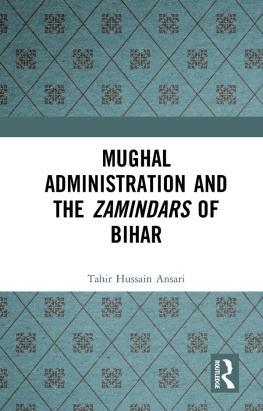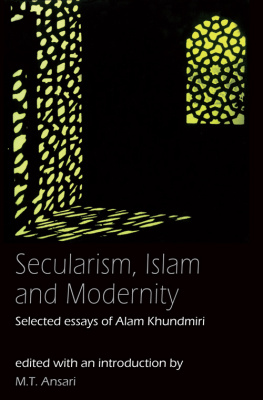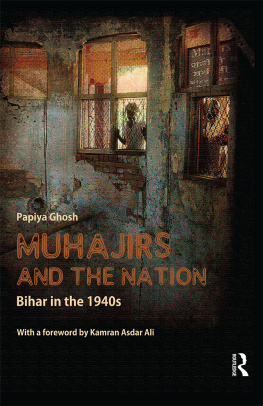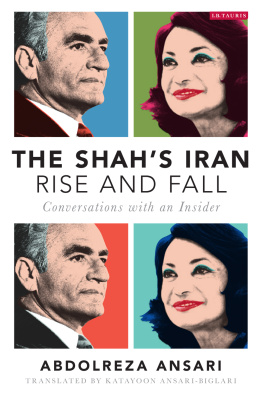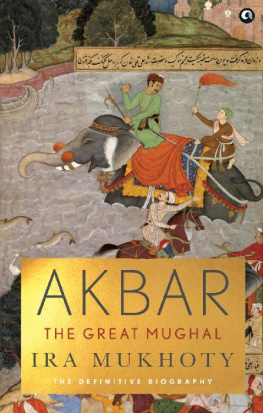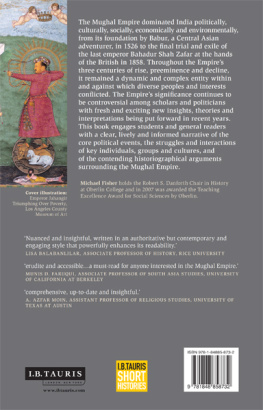Ansari - Mughal administration and the zamindars of Bihar
Here you can read online Ansari - Mughal administration and the zamindars of Bihar full text of the book (entire story) in english for free. Download pdf and epub, get meaning, cover and reviews about this ebook. City: Bihar (India), India., Mogul Empire, year: 2020, publisher: Routledge, genre: Romance novel. Description of the work, (preface) as well as reviews are available. Best literature library LitArk.com created for fans of good reading and offers a wide selection of genres:
Romance novel
Science fiction
Adventure
Detective
Science
History
Home and family
Prose
Art
Politics
Computer
Non-fiction
Religion
Business
Children
Humor
Choose a favorite category and find really read worthwhile books. Enjoy immersion in the world of imagination, feel the emotions of the characters or learn something new for yourself, make an fascinating discovery.
- Book:Mughal administration and the zamindars of Bihar
- Author:
- Publisher:Routledge
- Genre:
- Year:2020
- City:Bihar (India), India., Mogul Empire
- Rating:4 / 5
- Favourites:Add to favourites
- Your mark:
- 80
- 1
- 2
- 3
- 4
- 5
Mughal administration and the zamindars of Bihar: summary, description and annotation
We offer to read an annotation, description, summary or preface (depends on what the author of the book "Mughal administration and the zamindars of Bihar" wrote himself). If you haven't found the necessary information about the book — write in the comments, we will try to find it.
Ansari: author's other books
Who wrote Mughal administration and the zamindars of Bihar? Find out the surname, the name of the author of the book and a list of all author's works by series.
Mughal administration and the zamindars of Bihar — read online for free the complete book (whole text) full work
Below is the text of the book, divided by pages. System saving the place of the last page read, allows you to conveniently read the book "Mughal administration and the zamindars of Bihar" online for free, without having to search again every time where you left off. Put a bookmark, and you can go to the page where you finished reading at any time.
Font size:
Interval:
Bookmark:

THE ZAMINDARS OF BIHAR
This volume looks at the prominent chieftaincies of the suba of Bihar like Kharagpur, Bhojpur, Palamau, Gidhaur, Khokhra, Darbhanga, Champaran (Betia Raj) and Kalyanpur (Hathwa Raj) and presents the biographies of their chieftains to understand their relationship with the Mughal Empire from the period of Akbar to Aurangzeb and their power and position during the eighteenth and nineteenth centuries. It takes into consideration only those zamindars who enjoyed autonomous control over their possessions.
The volume examines the origin and growth of these chieftaincies and the manner of their subjugation as well as the nature of overlordship established by the Mughals over them. It also discusses the career and achievements of the chiefs at the Mughal court, particularly their appointments, awards of mansabs, promotions and so on.
The study is divided into ten chapters including Introduction and Conclusion. After the introduction, the next eight chapters are devoted to the study of chieftaincies. The ninth chapter is related to Hathwa Raj, which also includes a brief study of other chieftaincies like Panchet, Seor, Garhi, Ratanpur, Ramnagar, Ramgarh, Bhagwanpur, Chai and Kahalgaon.
The volume provides a complex portrait of the chieftains of Bihar and their relationship with the Mughal Empire as well as their role in the consolidation and expansion of the Mughal Empire in India.
Tahir Hussain Ansari is Assistant Professor in the Department of History, Assam University, Diphu Campus, Assam. His main area of research is political, social and economic history of Mughal Bihar during sixteenth to eighteenth centuries.
the Zamindars of Bihar
TAHIR HUSSAIN ANSARI


MANOHAR
2019
First published 2020
by Routledge
2 Park Square, Milton Park, Abingdon, Oxon OX14 4RN
and by Routledge
52 Vanderbilt Avenue, New York, NY 10017
Routledge is an imprint of the Taylor & Francis Group, an informa business
2020 Tahir Hussain Ansari and Manohar Publishers & Distributors
The right of Tahir Hussain Ansari to be identified as author of this work has been asserted by him in accordance with sections 77 and 78 of the Copyright, Designs and Patents Act 1988.
All rights reserved. No part of this book may be reprinted or reproduced or utilised in any form or by any electronic, mechanical, or other means, now known or hereafter invented, including photocopying and recording, or in any information storage or retrieval system, without permission in writing from the publishers.
Trademark notice: Product or corporate names may be trademarks or registered trademarks, and are used only for identification and explanation without intent to infringe.
Print edition not for sale in South Asia (India, Sri Lanka, Nepal, Bangladesh, Pakistan or Bhutan)
British Library Cataloguing-in-Publication Data
A catalogue record for this book is available from the British Library
Library of Congress Cataloging-in-Publication Data
A catalog record for this book has been requested
ISBN: 978-0-367-35468-8 (hbk)
ISBN: 978-0-429-33163-3 (ebk)
Typeset in Adobe Garamond 11/13
by Kohli Print Delhi 110 051

MANOHAR
To
My Beloved Parents
Abdul Sattar & R. Khatoon
It is a great pleasure for me to express my heartiest gratitude to my supervisor Prof. Afzal Husain, under whose valuable guidance, critical advice and constant encouragement, I was able to complete my doctoral thesis. He always gave me adequate space to discuss various themes of my work and accepted my views. Without his constant care, guidance and assistance, this work would not have seen the light of the day. He has always been an immense source of inspiration for me.
I am greatly indebted to my eminent teachers: Prof. Irfan Habib, Prof. Shireen Moosvi, Prof. I.A. Zilli, Prof. S. Zaheer H. Jafri and Prof. S.P. Verma, who not only helped and guided me in the completion of my research work but also always motivated me in my pursuit of knowledge. I am highly obliged to my esteemed teachers, Dr. M.K. Zaman, Prof. Ishrat Alam, Prof. Farhat Hasan, Prof. S. Ali Nadeem Rizavi and Prof. Jabir Raza who inspired me to complete my doctoral thesis. My thanks are also due to Prof. Mohd. Pervez, Prof. Mohammad Sajjad, Dr. Amir Ahmad and Dr. Reyaz Ahmad for their constant support in the completion of this study.
I am thankful to my friends, Syed Ali Kazim, Noor Hasan, Hammad Rizvi, Tabir Kalam, Mohammad Nazrul Bari, Ashfaque Ali and Amit Gaur who helped me in many ways to prepare my thesis in the present form.
Particularly, I am grateful to my loving parents, Late Mrs. R. Khatoon and Janab Abdul Sattar and my elder brother, Ashfaque Hussain, for their affection and blessings, which has been a great source of inspiration for me. I am equally indebted to my brother-in-law, Mazharul Hague and my sister, Aitun Nisha, for their constant encouragement.
I am beholden to the staff members of the Research Library, CAS, Department of History and Maulana Azad Library, Aligarh, especially to Arshad Ali, Mazhar Hussain, Salman Ahmad and B.D. Sharma for their cooperation.
I owe a debt of gratitude to the former director, Dr. Mohd. Ziauddin Ansari and the staff members of the Khuda Bakhsh Library, Patna, especially Hasibur Rahman, Ehsan Manzar, Irfan Ahsan Safdari, Iftekharunnabi Ahmad Madani, Md. Jawaid Ashraf and others for their kind cooperation. I would also like to thank the members of the K.P. Jayaswal Research Institute, Patna; the Bihar State Archives, Patna; and the Mahafiz Khana of the Darbhanga Raj, Darbhanga, for their valuable cooperation.
I am thankful to my colleagues in the Department of History, Assam University, Diphu for their kind cooperation and support.
Last but not the least, I must acknowledge my deep sense of love and gratitude to my wife, Sultana and my loving sons, Taha and Dayyan, who provided me strength and patience during the writing of this book.
Diphu TAHIR HUSSAIN ANSARI
| ASB | Asiatic Society of Bengal |
| BPP | Bengal Past and Present |
| IESHR | Indian Economic and Social History Review |
| IHR | Indian Historical Review |
| IHRC | Indian Historical Record Commission |
| JASB | Journal of Asiatic Society of Bengal |
| JBORS | Journal of Bihar and Orissa Research Society |
| JBRS | Journal of Bihar Research Society |
| JPRS | Journal of Pakistan Research Society |
| KPJRI | Kashi Prasad Jayaswal Research Institute |
| PIHC | Proceedings of Indian History Congress |
Introduction
During the Mughal period, we find references to a large number of territorial chiefs in almost every part of northern India. Locally, they were known as rajas, ranas, rais, raos, rawats
Font size:
Interval:
Bookmark:
Similar books «Mughal administration and the zamindars of Bihar»
Look at similar books to Mughal administration and the zamindars of Bihar. We have selected literature similar in name and meaning in the hope of providing readers with more options to find new, interesting, not yet read works.
Discussion, reviews of the book Mughal administration and the zamindars of Bihar and just readers' own opinions. Leave your comments, write what you think about the work, its meaning or the main characters. Specify what exactly you liked and what you didn't like, and why you think so.

